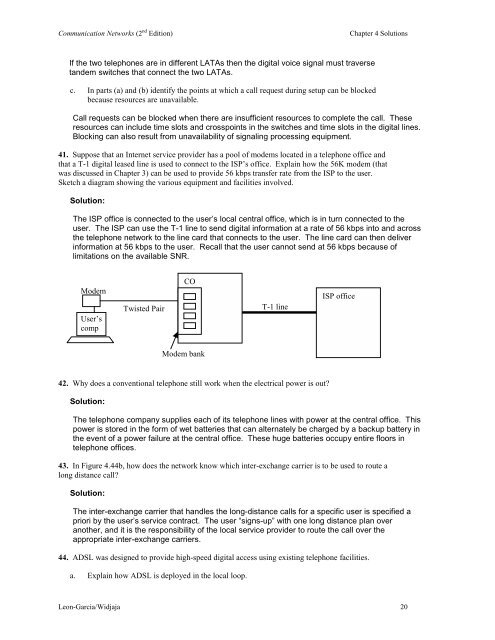Solutions to Chapter 4 - Communication Networks
Solutions to Chapter 4 - Communication Networks
Solutions to Chapter 4 - Communication Networks
Create successful ePaper yourself
Turn your PDF publications into a flip-book with our unique Google optimized e-Paper software.
<strong>Communication</strong> <strong>Networks</strong> (2 nd Edition)<br />
<strong>Chapter</strong> 4 <strong>Solutions</strong><br />
If the two telephones are in different LATAs then the digital voice signal must traverse<br />
tandem switches that connect the two LATAs.<br />
c. In parts (a) and (b) identify the points at which a call request during setup can be blocked<br />
because resources are unavailable.<br />
Call requests can be blocked when there are insufficient resources <strong>to</strong> complete the call. These<br />
resources can include time slots and crosspoints in the switches and time slots in the digital lines.<br />
Blocking can also result from unavailability of signaling processing equipment.<br />
41. Suppose that an Internet service provider has a pool of modems located in a telephone office and<br />
that a T-1 digital leased line is used <strong>to</strong> connect <strong>to</strong> the ISP’s office. Explain how the 56K modem (that<br />
was discussed in <strong>Chapter</strong> 3) can be used <strong>to</strong> provide 56 kbps transfer rate from the ISP <strong>to</strong> the user.<br />
Sketch a diagram showing the various equipment and facilities involved.<br />
Solution:<br />
The ISP office is connected <strong>to</strong> the user’s local central office, which is in turn connected <strong>to</strong> the<br />
user. The ISP can use the T-1 line <strong>to</strong> send digital information at a rate of 56 kbps in<strong>to</strong> and across<br />
the telephone network <strong>to</strong> the line card that connects <strong>to</strong> the user. The line card can then deliver<br />
information at 56 kbps <strong>to</strong> the user. Recall that the user cannot send at 56 kbps because of<br />
limitations on the available SNR.<br />
Modem<br />
User’s<br />
comp<br />
Twisted Pair<br />
CO<br />
T-1 line<br />
ISP office<br />
Modem bank<br />
42. Why does a conventional telephone still work when the electrical power is out<br />
Solution:<br />
The telephone company supplies each of its telephone lines with power at the central office. This<br />
power is s<strong>to</strong>red in the form of wet batteries that can alternately be charged by a backup battery in<br />
the event of a power failure at the central office. These huge batteries occupy entire floors in<br />
telephone offices.<br />
43. In Figure 4.44b, how does the network know which inter-exchange carrier is <strong>to</strong> be used <strong>to</strong> route a<br />
long distance call<br />
Solution:<br />
The inter-exchange carrier that handles the long-distance calls for a specific user is specified a<br />
priori by the user’s service contract. The user “signs-up” with one long distance plan over<br />
another, and it is the responsibility of the local service provider <strong>to</strong> route the call over the<br />
appropriate inter-exchange carriers.<br />
44. ADSL was designed <strong>to</strong> provide high-speed digital access using existing telephone facilities.<br />
a. Explain how ADSL is deployed in the local loop.<br />
Leon-Garcia/Widjaja 20







